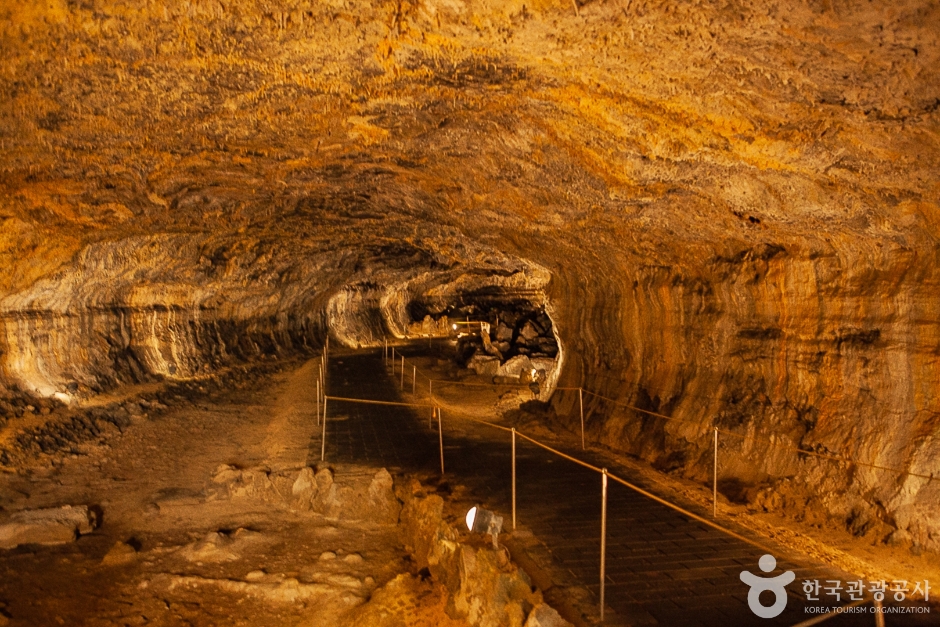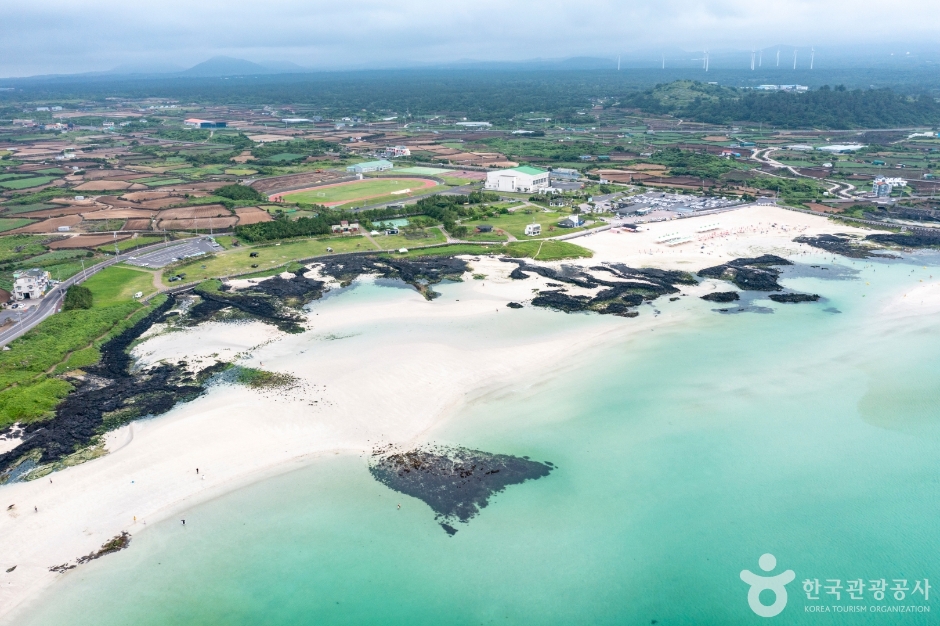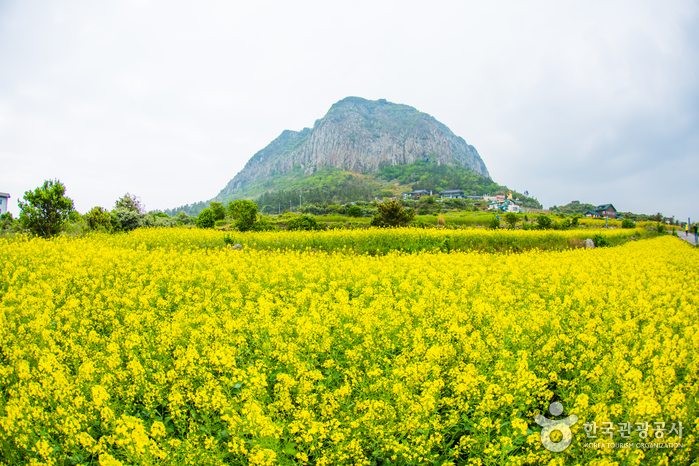Hyeopjaegul Lava Tube (Hallim Park) (협재굴(한림공원))
2025-03-13
300 Hallim-ro, Jeju-si, Jeju-do
+82-64-796-0001
Hyeopjaegul Lava Tube is one example of the lava tube systems of Jeju Island, along with Hwanggeumgul, Socheongul, Ssangyonggul and Manjanggul Lava Tubes. The cave is approximately 200 meters in length, 10 meters in x_width and 5 meters in x_height. It is thought to have been created by the lava that erupted from Hallasan Mountain some 25 million years ago. This cave uniquely contains features of both lava and limestone caves. The entire area surrounding the cave is a huge stratum of seashells and sand, while the interior of the cave has a mystical ambience due to its various formations such as stalactites and stalagmites, hanging from the ceiling and sprouting up from the bottom of the cave. The cave also features pillars formed when stalactites and stalagmites join together. The cave walls are covered in lime, which at times looks like beautiful cave paintings. The temperature inside the cave stays at 17~18℃ throughout the year, making the cave a welcome escape from the summer heat and a great place to keep warm during winter.
Hyeopjaegul Lava Tube has been designated Natural Monument No. 236 and ranks among the world’s major mysterious caves, such as the stone salt cave of Peru and the underwater limestone caves of Yugoslavia. As Hyeopjaegul Lava Tube is close to Ssangyonggul Lava Tube, the two can be visited on the same day.
Gimnyeongsagul Cave [UNESCO World Heritage] (김녕사굴 [유네스코 세계자연유산])
2022-12-29
34, Manjanggul-gil, Jeju-si, Jeju-do
+82-1600-0064
Gimnyeongsagul Cave is located close to Manjanggul Cave in the northeastern part of Jeju Island. The name of the cave, "Sagul," comes from the snake-like formation of the cave ("sa" meaning serpent). The entrance of the cave is wide like a serpent holding its mouth wide open, but once inside, the tunnel narrows resembling the body of a snake. Gimnyeongsagul Cave is a highly protected area and has been designated as Natural Monument along with Manjanggul Cave.
Gimnyeong Seongsegihaebyeon Beach (김녕성세기해변 (김녕해수욕장))
2024-11-14
237 Gujwahaean-ro, Jeju-si, Jeju-do
The clear waters that are highlighted with cobalt-blue and the clean white sand of Gimnyeong Seongsegihaebyeon Beach steal the hearts of visitors every year. The beach is also popular with fishermen, who enjoy rope fishing from the rocks. This area is known to be good for catching striped beakfish and spotty belly greenlings. Not far from the beach is Manjanggul Cave, which offers a welcome escape from the daytime heat.
Sanbangsan Mountain (Jeju) (산방산(제주))
2024-03-12
Andeok-myeon, Seogwipo-si, Jeju-do
+82-64-794-2940
Sanbangsan Mountain, meaning "mountain with a cave," is home to Sanbanggulsa Temple, a small temple located at the foot of the mountain where a Buddha statue is enshrined. According to Jeju mythology, it is said that the grandmother deity, Seolmundae Halmang, tossed aside a rock from Hallasan's summit, forming this mountain. Standing at 395 meters above sea level on the southwestern coast of Jeju Island, Sanbangsan Mountain boasts vibrant fields of mustard flowers in spring, creating a picturesque view against the backdrop of the mountain.
Dangcheomuldonggul Cave [UNESCO World Natural Heritage Site] (당처물동굴 [유네스코 세계자연유산])
2020-04-23
Woljeong-ri, Gujwa-eup, Jeju-si, Jeju-do
+82-1600-0064
Dangcheomuldonggul Cave, located in Jeju, is a lava tube estimated to have been formed some 320,000 years ago due to volcanic activity; it is located approximately 3 kilometers underground. With no entrance as such, the cave is not open to the general public and thus its original form remains preserved to this day, giving it a high geological value.
Although the Dangcheomuldonggul Cave is technically a lava tube, it resembles a limestone cave due to the secondary geological formations
of lime substances that have accumulated in the ground above the tube. The tunnel has a spectacular and mystical beauty with countless stalactites and stalagmites, as well as stalactite columns. The particularly thin stalactites and stalactic columns in this cave are well-known for their uniqueness and beauty. Although this is a relatively small lava tunnel, its exotic colors and the richness of the secondary topological formations make it extraordinary in terms of research value. This cave has been designated natural monument.
* The UNESCO World Heritage inscribed Geomun Oreum Lava Tube System consists of Bengdwigul, Manjanggul Cave, Gimnyeonggul, Yongcheondonggul and Dangcheomuldonggul Caves.
Samyang Beach (삼양해수욕장)
2022-07-28
Samyang 2-dong, Jeju-si, Jeju-do
+82-64-740-6000
Samyang Beach is cozy and has clear waters because it is not well-known among tourists. In particular, it stands out because of its sparkling black sand. As the black sand's therapeutic effect is well known, visitors can often be seen lying down on the beach and burying themselves in the black sand.
Gimnyeong Maze Park (김녕미로공원)
2024-03-13
122 Manjanggul-gil, Gujwa-eup, Jeju-si, Jeju-do
+82-64-782-9266
Gimnyeong Maze Park is intricately designed with towering evergreen trees, each reaching up to three meters in x_height, creating an natural labyrinth. The pathways are paved with scoria, a natural volcanic rock characteristic of Jeju, enhancing the authentic island feel. As visitors navigate the maze, the refreshing scent of evergreen trees fills the air, providing a sense of clarity and rejuvenation. Along the route, visitors can encounter unique dolmens and their feline residents. The park also features an observatory and a suspension bridge, offering breathtaking panoramic views. Gimnyeong Maze Park is a favorite destination for families, children and couples alike, providing a memorable experience for all.
Gimpo Jangneung Royal Tomb [UNESCO World Heritage] (김포 장릉(인헌왕후) [유네스코 세계문화유산])
2022-12-16
79, Jangneung-ro, Gimpo-si, Gyeonggi-do
+82-31-984-2897
Jangneung Royal Tomb is located in Gimpo, Gyeonggi-do. This is the tomb for the parents of King Injo, the posthumously designated King Wonjong (1580-1619) and of his wife Queen Inheon (1578-1626). The tombs are small but well maintained.
Soesokkak Estuary (쇠소깍)
2024-03-26
104 Soesokkak-ro, Seogwipo-si, Jeju-do
+82-64-732-1562
Soesokkak Estuary is a valley formed where fresh water meets seawater, creating deep pools. The harmony of deep blue water, volcanic rock formations, and dense pine forests creates a mystical atmosphere. Visitors can explore deep into Soesokkak Estuary by riding a tewoo or kayak. Following the walking trail leads to Hahyo Soesokkakhaebyeon Beach, famous for its black sand.
Paju Jangneung Royal Tomb [UNESCO World Heritage] (파주 장릉(인조, 인열왕후) [유네스코 세계문화유산])
2021-07-19
90, Jangneung-ro, Paju-si, Gyeonggi-do
+82-31-945-9242
Located in Paju, Jangneung is the tomb of King Injo (1595-1649, reign 1623-1649), the 16th ruler of the Joseon dynasty, and Queen Inyeol.
King Injo took the throne in 1623 after having overthrown the previous king, Gwanghaegun, in a military revolt. During his reign, King Injo faced challenges from two foreign invasions in 1627 and 1637. He died in 1649 in Changdeokgung Palace.

![Gimnyeongsagul Cave [UNESCO World Heritage] (김녕사굴 [유네스코 세계자연유산])](http://tong.visitkorea.or.kr/cms/resource/37/1618237_image2_1.jpg)



 English
English
 한국어
한국어 日本語
日本語 中文(简体)
中文(简体) Deutsch
Deutsch Français
Français Español
Español Русский
Русский